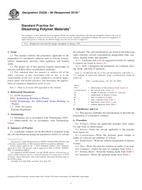1.1 This practice covers standardized procedures for the quantitative sensory assessment of the reduction of perceived olfactory intensity of indoor malodors, for the purpose of assessing the deodorant efficacy of air freshener products. This practice is confined to static conditions only.
1.2 The determination of this efficacy can be useful for establishing performance claims for a given formulation, and for substantiation of those claims in product advertising. However, one must be aware that certain types of claims exist that this type of testing will not support.
1.3 This practice is limited to the assessment of a specific malodor intensity by trained judges under controlled laboratory conditions. Methods that reflect actual consumer environmental conditions are valid for selected sensory tasks, but they may be less sensitive. Methods that include highly controlled environmental conditions will increase the chances of detecting small differences among treatments. The degree of control of extraneous experimental factors in an experiment is variable and is governed by the purpose of the test, amount of resources available to provide that degree of control, and desired level of statistical sensitivity (see Appendix X3).
1.4 Selection of representative malodor sources is of critical importance. The malodor source must be readily available and of a consistent odor quality. A reasonable malodor source should be chemically and aesthetically correct. The experimenter and client must agree upon the appropriateness of a malodor source before further details of the test design are worked out. Experimental variation will be reduced by using uniform malodor sources. Information collected on malodor reduction will thus be more comparable from experiment to experiment and from laboratory to laboratory.
1.5 It is recognized that, while sometimes desirable, the use of actual “live” malodors is often impractical due to the inherent variability of the malodor sources. A true malodor source may be used when practical. However, the use of a formulated odor source has several advantages, including consistency and availability.
1.6 Air freshener products are sold commercially with the intent of providing a means of improving the odor quality of a volume of air, relative to some existing environmental condition. This typically involves the application of an odorous substance into the air space by means of some mechanical or physical mechanism. When the existing environment includes some undesirable odor source, or malodor, reduction of the perception of the malodor is usually accomplished with other odorous substances by masking. This procedure is also applicable to other mechanisms of odor reduction.
1.7 The purpose of this practice is to assess the ability of air freshener products to reduce indoor air malodor intensity from a control state. Several experimental hypotheses are possible, depending on the objective of the test. Possible objectives with respective hypotheses are given in Appendix X1.
1.8 This standard does not purport to address all of the safety concerns, if any, associated with its use. It is the responsibility of the user of this standard to establish appropriate safety and health practices and determine the applicability of regulatory limitations prior to use. Specific precautionary statements are given in Section 6 and X3.6.3.7.
Product Details
- Published:
- 09/10/1999
- Number of Pages:
- 11
- File Size:
- 1 file , 110 KB


